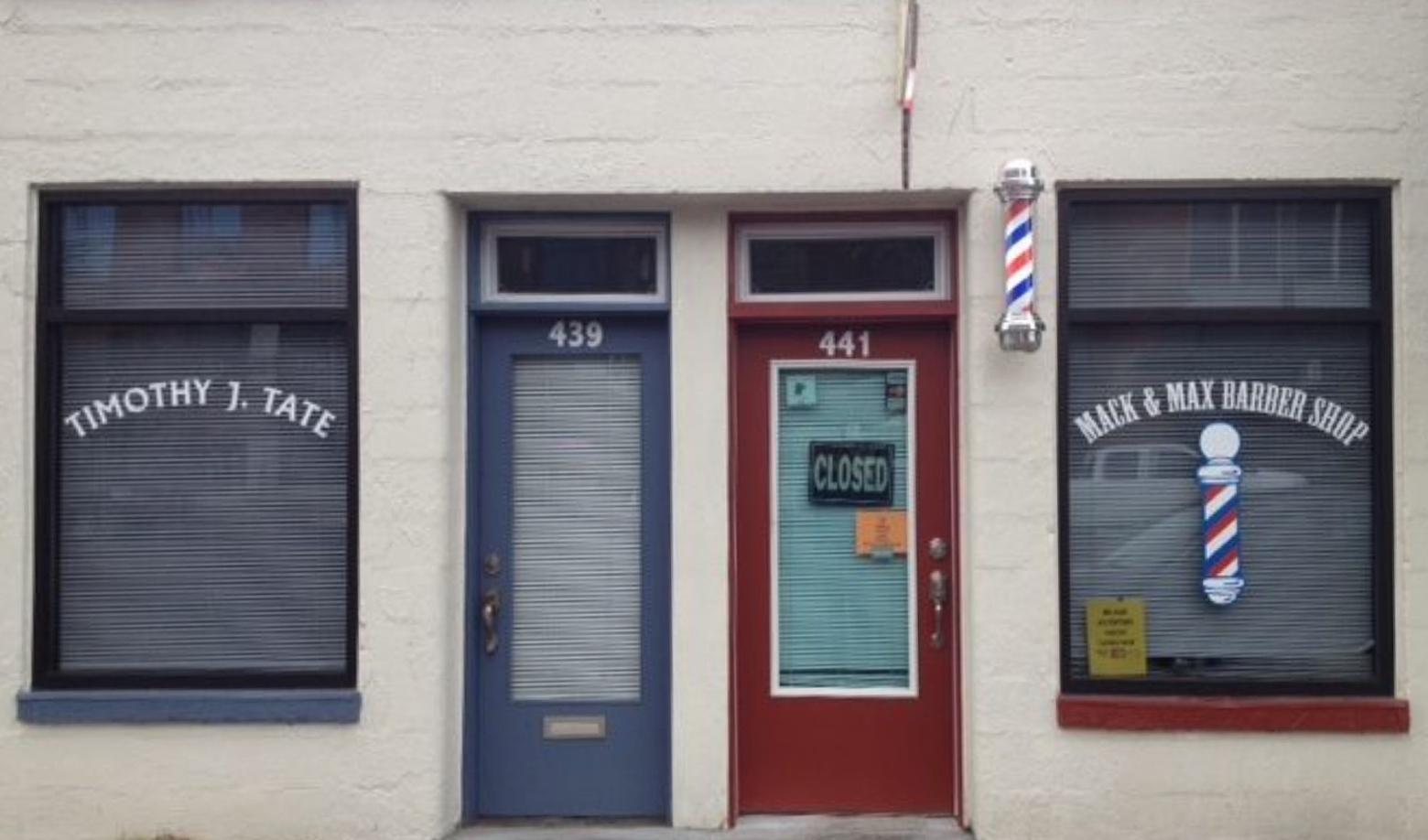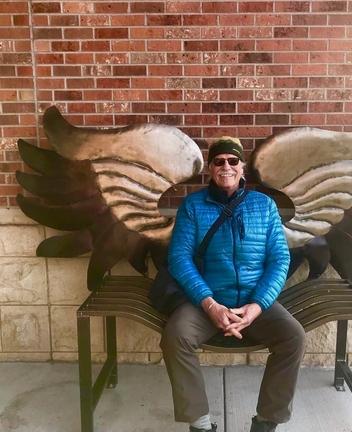Back to StoriesFor A Generation, "The Blue Door" Was A Safe Space On Bozeman's Main Street
September 5, 2017
For A Generation, "The Blue Door" Was A Safe Space On Bozeman's Main StreetPsychotherapist Timothy J. Tate says the biggest downside of his community becoming the "it" place is the loss of handshake agreements
In my weekly interludes with you here, I will often make passing reference to The
Blue Door. My reader friends outside of
Bozeman may not realize that, for a few decades, The Blue Door was my calling
card at 439 East Main Street.
Nothing more than the numbers to the address of
my practice as a psychotherapist and my name stenciled on the window provided any inkling.
Although I’ve since moved my digs just around the corner, my
office was both conspicuous given its location and discreet in that, unless you
were paying visits or knew someone who was, you might not have a clue of what
went on behind the closed blinds.
There is a lot of talk in these modern times about the need
to create “safe spaces” where we can be secure to share what’s on our minds. The realm on the other side of The Blue Door is one of the places where I glean
insight into the undertow of community. Every kind of human challenge has been discussed,
part of a broader pattern of social interaction that is the journey of life in
the Greater Yellowstone Ecosystem.
Reflecting on the importance of having your own version of
The Blue Door, no matter what form it takes, got me to thinking of how the
location of my office started with a handshake deal.
Here's how I remember it: Very clearly, I still recall how the back of my landlord's fingers were weathered like only a
blue-collar man’s hands can be; more like a creased and worked paw; like a side
of ham that defied gripping.
He knew I was seeking a space to set up my practice. We
settled on a $125 monthly rent for the 190 square-foot room next to Al’s Barber
Shop and two doors west of the Western Café, a greasy spoon institution. He owned the building that housed
all three businesses.
As a triad, they are part of one of the oldest structures in Bozeman
dating back to a time when mule trains rested on the dirt road, hitched and
sturdy in their stance, maybe six teams pulling covered wagons plump with expectations.
Main Street was a westward shortcut blazed by our town’s founder John Bozeman, who poached a settler trail illegally across Indian treaty lands in order to reach the gold fields in
Virginia City.
Over time, the muddy route rutted with wagon wheel tracks turned into a four-lane state highway. Even in 1988 when this story begins, buckaroos and cowgirls would still ride their horses past
the window of my office, either working their steeds to be unafraid of traffic
or just passing through on their way to greener pastures. Once, as legend has it, a hippy during the 60s was lassoed by a wrangler who treated him like a steer in a roping context and cut off his locks because Bozeman, unlike Missoula, wasn't a place for long hairs.
But back to my story: Dave the new landlord told me that I would be responsible for
upkeep and maintenance deducting whatever necessary work cost from my rent.
There was no lease, just a monthly good faith payment that I would mail to his home
address on the first of every month.
Whenever Dave would stop in for a haircut with Al or bacon
and eggs with Dick and Alice at The Western, he would also give a wave to me or if I was
not in session stop by for a visit.
We wouldn’t say much. I don't think he ever quite comprehended the work that happened in my space but it didn't matter. The texture of our conversation
reminded me of my Eastern Montana years listening to the sweet melody of meadowlarks, the sagebrush
pungent with morning dew, and ranch hands lining out the day’s work. Our chats were sparse, unforced, and unencumbered, our words couched in comfortable silences accented
with occasional joshing. You didn't have to say something profound to trust in the connection.
For years prior, I had held counseling sessions in the study
of our home on North Wallace. This historic home was an example of the brick
cottages built around the turn of the twentieth century that sheltered honest
hard-working citizens materializing their American dream. Bozeman, need I say
it, was much quieter then.
My wife, Susan and I moved from Miles City and were
gob-smacked with early eighties Bozeman, the tree-lined streets and how our white
picket fence idyllically fronted the peaked gabled brick home with its front
porch and separate entrance for the office/study.
Back in those days, Bozeman exhibited no sign of oneday
becoming one of the “it” places to be in America. It was quiet, lacked attitude and the ambition
that somehow to be legitimate it had to morph into something else. Susan and I
wanted to plant roots the way many couples do.
Leaving one decision to fate, we agreed that we allow a year
to pass without using birth control to see if a pregnancy would bless us. I was
approaching forty and she thirty-eight so it felt like the conception,
pregnancy, and birth clock was ticking loudly.
Earlier that year, we led a group down into the Yucatan to
visit and meditate on the ancient Mayan ruins in Palenque, Tikal, and other
more hidden sites like the “mystery school” at Edzna. I was moved by an image
of the Temple of the Grand Jaguar at Tikal, what with its hundreds of steps
leading up the jungle’s canopy and the mist shrouded foyer of the gods. In
preparation for our group adventure, I lead weekly 6 a.m. meditation sessions.
Seven brave women joined us and for a month we travelled
together. At the end of that time we spent a week or so in Playa del Carmen
with its dirt roads, Palaypas, Tiendas, and our home for the stay, the Banana
Cabanas. It was here in privacy that our Mayan-influenced hitchhiker, daughter
Abbey, came on board.
Not long ago, we returned to Mexico with Abbey as then a
twenty-six year old woman to see if we could find the Banana Cabanas. All we
found was the exploding spasm of a contorted sprawling mass of Cancun South,
that Playa had become. It’s hard to
reconcile how its discovery by the masses resulted in anything that enhanced
its original charm.
When we were back in Bozeman and the stick turned blue,
confirming Abbey’s arrival, Susan looked at me dumbfounded, since it was at the
end of our year of not using protection, declaring as only she can: “You
knocked me up!”
What this meant on a purely practical level was that I had
to find a new office space since my study would become the baby’s nursery. And
as I am wont to do I walked Main Street later in the year looking for a space
to put out a shingle.
And I headed to The Western for breakfast. Seeing a For-Rent
sign in a storefront window that used to house a yarn shop called “The Real Ewe”,
I called the number. Dave and I met, we
cut a deal, but it did not include the yarn shop sign which, in jest, I thought
of changing to read “The Real You” as the advertisement for my practice.
After we shook hands, Dave gave me the key and home I went,
elated that such a space of character opened up. Right on Main Street. That night, I had a dream visualizing a front
view of the newly-found space. It looked just like it did but the façade was
painted bright white and the door was a big sky blue.
On that cue, Susan and I painted the space according to the
dream’s palate, remodeled the interior from its former use as an insurance
agent’s, locksmith, and yarn shop retail use to the quiet of a locked Blue Door
consulting room. An artist in my practice agreed to paint ‘Timothy J. Tate’ in
an arc on the front window leaving as a mystery, behind the venetian blinds, of
what happened there.
Years passed on and the term of the handshake never wavered.
And then I received word that Dave had passed. With no fanfare or disturbance
the handshake with Dave effortlessly transferred to his widow Minerva. The
second handshake transferred to a woman I had never met.
I bet over the years I have listened to sincere individuals
share hundreds of thousands of dreams in my office. We have been entertained,
evoked, disturbed, motivated, and found new direction through their illusive
yet demanding imagery in the quest to make sense of them.
Not so long after Dave left us, Minerva did, too, and the handshake
deal was inherited by her soul survivor, her nephew, Robbie. There were no attorneys called in or
consultants paid to offer advice on how the building should be treated as a real
estate play to maximize profit. The monthly rent and conditions remained the
same, just the name and address on the check changed.
More years passed, as did Robbie. He died while walking the
Gallatin Mall. His wobbly, wandering gait stalled and collapsed while
exercising. His eccentric mild-mannered nature punctuated with off color jokes,
some really funny, others mildly offensive, went with him to the grave.
It would have been a fairy tale to believe things would
forever remain the same. Sure enough, ownership of the three adjacent
structures changed. A three-year lease, some twenty pages long, followed.
The barbers and I met with her in the Western and negotiated
the terms in a tense yet respectful conversation over the table where I had
consumed the special of breakfast sausage, eggs up, rye toast and hash browns
so many times with patrons, including an actor who played Batman.
When the lease expired, so did my tenure behind The Blue
Door, among a long list of expirations affecting mom and pop family
establishments that used to define the six blocks of downtown.
I had hoped to take The Blue Door with me. I wrote a hand
written letter to my landlady expressing a bit of history, sharing how I had
paid for The Blue Door in so many ways. As a gesture for which I am eternally
grateful, I received an answer from her attorney stating that it would be
gifted to me.




